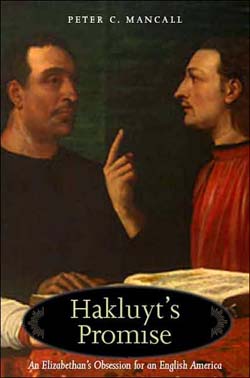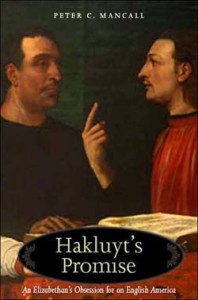The Obsessive Richard Hakluyt

A conventional biography of Richard Hakluyt the younger (1552?-1616) cannot be written. Famous for publishing collections of travel writings in order to promote English colonialization, Hakluyt left no personal papers. We know he married twice, the first marriage producing a son. Beyond dates of marriages, deaths, and births, no trace of his private life survives. Literally the only information of a quasi-personal nature comes from a passage in one of his published works, in which he describes the introduction to geography that would later launch him on his publishing career. It is an exceedingly thin record for a man whose name is so well known.
Peter C. Mancall skirts this problem mostly by focusing on the larger context rather than by trying to fill in what cannot be known with “might have beens.” The relative conservatism of his approach can be seen by contrasting Hakluyt’s Promise to Natalie Zemon Davis’s recent Trickster’s Travels: A Sixteenth-Century Muslim Between Worlds (2006). Unlike Davis, who uses general information to illuminate her subject, Mancall demurs almost entirely from speculative reconstructions. On one uncharacteristic occasion, he unequivocally declares the years 1590 to 1600 “the most personally painful part of his life” (196). This unusually direct factual statement depends on the knowledge that during this decade a number of people close to Hakluyt died, including his first wife. This tentative foray into the inner life of the man is not supported by the sort of ancillary information (for instance about early seventeenth-century attitudes toward death) that Davis would have used to fill this gap.
Mancall uses what has survived to depict Hakluyt’s interest in English expansion and especially colonization in the Americas. Using Hakluyt’s own publications as well as other exploration accounts that were available at the time, he charts the widening awareness of other places that Hakluyt both experienced and fostered. Mancall describes in detail the adventures of various explorers and analyzes Hakluyt’s editorial choices. In this treatment the geographer comes through as the consummate advocate for English involvement in the wider world. He argued relentlessly in favor of a greater role for England, trying to present the available materials in the best possible light. Reading Mancall will help the reader who is already familiar with Hakluyt understand the decisions he made about what to present and how to present it. The reader can also see the trouble he went to in order to collect what he published, interviewing travelers and pouring over their accounts. The reader who is less familiar with Hakluyt will get the flavor of his books, since Mancall provides detailed summaries of each. Hakluyt’s life’s work, to the extent that it is captured in his publications, takes center stage in this history.
Despite the evidentiary hole that has swallowed up most of what one would want to know of the life of this famous colonial promoter, the book jacket of Hakluyt’s Promise nonetheless claims that it “describes in detail the life and times” of its subject. It might not be entirely fair to hold an author accountable for publisher’s claims on book jackets—possibly not every press asks its authors to ghost write these embarrassingly effusive descriptions. Yet, the book itself brings to mind the “life and times” genre. It attends more to broad context than to its ostensible subject. The writing is also vividly detailed, making a bid for the popular audience associated with the typical “life and times.” Yale has produced a handsome volume, the lovely cover image of two geographers (from the 1516 Sebastiano del Piombo oil painting Cardinal Bandinello Sauli, His Secretary, and Two Geographers) hinting at the many illustrations inside.
Mancall does not entirely conform to the requirements of popular history writing, however, as he neglects to provide information on basic aspects of life in Elizabethan England. For instance, when discussing Hakluyt at Oxford, Mancall does not describe college life generically, though this would help readers see how Hakluyt would have spent his days, what he was expected to learn, and how he would have done so. Instead, Mancall limits himself to suggesting opportunities that might have existed for Hakluyt to learn about geography. He wants to explain the man’s future obsession, which the book’s subtitle refers to as “An Elizabethan’s Obsession for an English America.“
The “times” that Mancall explores are largely confined to what was contained within the covers of books. Many chapters offer lengthy descriptions of books that Hakluyt wrote or compiled. Since these publications make up the preponderance of surviving material, it is not surprising Mancall devotes so much space to them. In addition to these summaries, Mancall provided extensive descriptions of other products of the contemporary press. A chapter on Hakluyt’s time in Oxford in 1577 takes up an epidemic in that year and an earthquake that occurred three years later. Mancall lays out the debates in the press about how to interpret God’s intention in these events, reviewing differing messages that observers might have drawn, given the providential framework they all used. Leaving these topics to return to Hakluyt (who left no information on his experience of or views on these events), Mancall notes that these interpretive battles over community hardships “would have symbolized the traditional views of the Church of England and its orthodoxy” to Hakluyt (69). While speculation on earthquakes and epidemics makes for interesting reading, the relationship of any of this to Hakluyt is tenuous, and these popular publications offered a very odd angle on the views of a man trained as a Church of England clergyman.
The book’s title, Hakluyt’s Promise, refers to a promise or perhaps a resolution that Hakluyt made after he became interested in geography while visiting his older cousin at the Middle Temple in 1568. The cousin, also named Richard Hakluyt and also interested in geography, is dubbed “the lawyer” to keep his identity separate in the text. The effect may be to emphasize his identity as an attorney more than is warranted, since his biggest impact on his younger cousin’s life was as mentor. What precisely the younger Hakluyt may have promised himself at this moment is nowhere clearly stated, however.
The subtitle, An Elizabethan’s Obsession for an English America, is an accurate presentation of Mancall’s interests, although not entirely of Hakluyt’s. In his last years the geographer and promoter turned toward the East, expending more of his energies on promoting an English presence in that direction. He thought America a likely arena for English success, but like all his contemporaries, he valued the trade with the East above all else. Much of the obsession with America was with finding a way through it or around it, as in the famed but elusive Northwest Passage. One might even say that Hakluyt was mostly obsessed with how to get beyond America. Hence his late-life interest in the Orient did not represent a turn away from an earlier focus on America.
The book is thus perhaps of most interest to an American audience. For those who want a Hakluyt biography, this book will disappoint not only for the information about the man’s life that is unavailable but also for Mancall’s choice not to recreate the context of his life to the extent that surviving records make possible. For those who want a “life and times,” it comes a bit nearer to the mark, although it lacks the broad perspective on the larger society and its political and cultural framework that one might expect such a volume to contain. For those who, like Hakluyt himself and like Mancall as well, are interested in books, this volume offers a well-written guide through Hakluyt’s own writings, as well as those of other popular contemporary authors. While it cannot give us enough to understand how Hakluyt became obsessed with America or with expansion more generally, it clearly shows what he did with that obsession once he had been bitten by the bug of geography.
This article originally appeared in issue 8.1 (October, 2007).
Carla Gardina Pestana is the W. E. Smith Professor of History at Miami University. She has written on religion and the early English Atlantic colonies.
